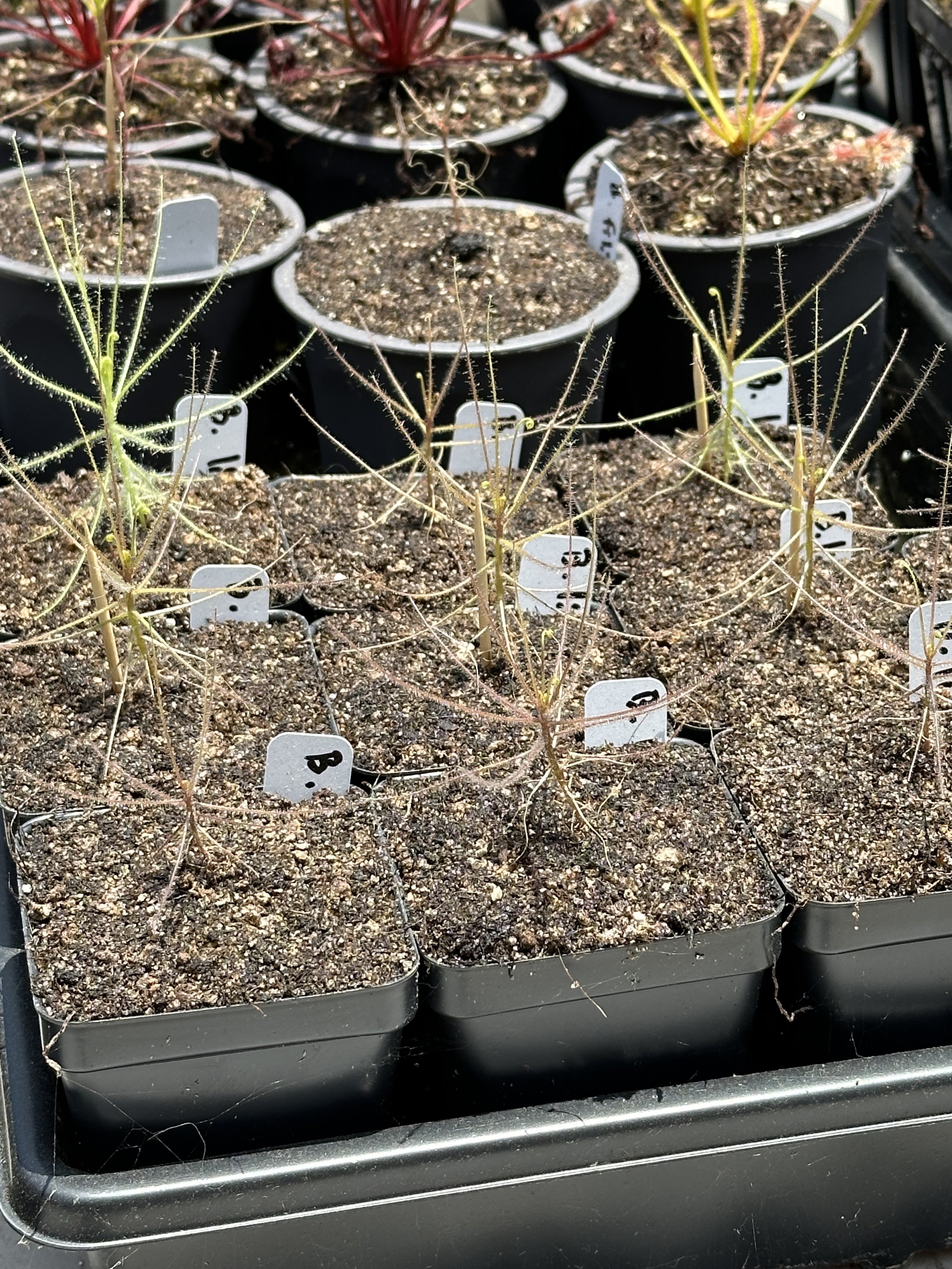Rainbow Plant (Byblis) Cultivation




General Info:
Byblis (also called Rainbow Plants) are a beautiful genus of carnivorous plants that have dew covered leaves that glisten in the light. Most grow a vertical or scrambling stem with elongated leaves covered in translucent hairs that secrete a dewy mucilage. Byblis evolved carnivory independently of all the other sticky carnivores and are the only members of their entire plant family. These are especially beautiful and unique amongst the carnivorous plants!
There are two main types of Byblis, the annuals from Northern Australia and New Guinea, and the perennials from Southwestern Australia. The annual species grow in hot and wet environments in bright sun. They are easy to grow outdoors in the summer in warm climates. They will also grow well indoors under strong lights if the temperatures stay warm. Under bright light, the leaves may take on a slightly purplish color which contrasts with the bright green.
Annual Byblis species sprout from seed and grow very quickly, reaching a few inches tall within 1 month. The most common species, Byblis liniflora, grows to around 4-12” tall in a compact, miniature tree shape. Other annual species, like Byblis filifolia, will grow much taller stems that can reach 1-2 feet long, but will typically fall over after a certain height. This is natural and the plants will just repoint the tip up towards the light and continue extending. I have grown Byblis guehoi under lights and the stems continued to grow to over 6 feet long and flowered for a year. Byblis aquatica grows upright with a more robust stem and can turn reddish in strong light. It prefers waterlogged conditions and likes to grow wetter than other species. Very bright sun can keep the plants more compact and upright and can seemingly induce more prolific flowering, but also a quicker decline after the mass bloom.
In late summer, they will produce tons of bright purple/pink/magenta flowers. Some plants can be completely covered in flowers and this must be the most colorful display of any carnivorous plant. The flowers of Byblis liniflora easily self-pollinate, but other species require manual pollination. For these species, the pollen will not be released until buzzed by a flying insect (or some type of vibration). I use an electric toothbrush to collect pollen and manually pollinate. They produce relatively large, black seeds. After seeding, the annual plants will slowly decline, especially if the weather cools down in the Fall.
The seeds of Byblis liniflora and Byblis aquatica can often germinate readily on their own, but a treatment with gibberellic acid (GA3) at roughly 500ppm for 24-72 hr can improve germination rates substantially (especially in the other annual species). Overall, the annuals are easily to grow in warm and wet conditions, and do best with strong light.
The perennial species, Byblis gigantea and Byblis lamellata are from Southwest Australia and prefer a milder climate and low humidity. Summers in the wild can be very hot and plants can go die back to the roots during summer (though this does not happen if kept wet in cultivation). The soils should be well draining and moist but not soggy. High light is essential for healthy plants. These can grow woody stems and have a more shrub-like appearance that can vary between individual plants. The leaves are more erect and the growth habit is more reminiscent of Dewy Pines. I will update this page with more information as I gain more experience with these species.
Cultivation:
Annual Species (Byblis aquatica, Byblis liniflora, Byblis filifolia, Byblis guehoi, Byblis rorida, Byblis pilbarana)
Climate: Temperatures from 60-100F, prefers high humidity but can adapt to lower humidity. These love heat and grow incredibly fast when kept hot.
Light: Part to Full Sun or 20W per sq ft LED light.
Water: Distilled or Reverse Osmosis water. Sitting in 0.5”-2” of water using tray method.
Soil: 40% Peat Moss: 40% Sand: 20% Perlite or other well draining peat + sand mixes. Rinse media with distilled or reverse osmosis water to remove excess salts.
Feeding: Plants outdoors will catch lots of flies on their own. Feed fish food or roughly 200-500ppm foliar fertilization if they are not catching enough or if growing indoors.
Perennial Species (Byblis gigantea, Byblis lamellata)
Climate: Temperatures from 45-95F.
Light: Full Sun or at least 25W per sq ft LED light.
Water: Distilled or Reverse Osmosis water. Top watering or sitting in 0.5” water in tall pots.
Soil: Granular, well draining mixes are essential. Mixes of perlite, akadama, sand, with some peat (<35"%) are common, but the exact ratios will depend on watering conditions.
Feeding: Plants outdoors will catch lots of flies on their own. Feed fish food or roughly 200-500ppm foliar fertilization if they are not catching enough or if growing indoors.
Notes:
Byblis must be grown by seed as other method of propagation don’t really work.
Smaller plants appreciate higher humidity, though they can be gradually acclimated to lower humidity once larger.
Outdoors, they can tons of insects. I am testing fish food powder as a food indoors.
The annual species are lowland tropicals, the perennial species are Mediterranean climate and have differences in growing methods.
While B. liniflora readily self pollinates, B. filifolia and others require cross pollination with a different individual. Manually pollinating B. liniflora can help increase seed production.